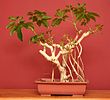Heptapleurum arboricola
| Heptapleurum arboricola | |
|---|---|

| |
| Schefflera arboricola in cultivation | |
| Scientific classification | |
| Kingdom: | |
| (unranked): | |
| (unranked): | |
| (unranked): | |
| Order: | |
| Family: | |
| Subfamily: | |
| Genus: | |
| Species: | S. arboricola
|
| Binomial name | |
| Schefflera arboricola | |
Schefflera arboricola (syn. Heptapleurum arboricolum) is a flowering plant in the family Araliaceae, native to Taiwan as well as Hainan.[1][2] Its common name is dwarf umbrella tree, as it appears to be a smaller version of the umbrella tree, Schefflera actinophylla.
Growth
It is an evergreen shrub growing to 8–9 m tall, free-standing, or clinging to the trunks of other trees. The leaves are palmately compound, with 7–9 leaflets, the leaflets 9–20 cm long and 4–10 cm broad (though often smaller in cultivation). The flowers are produced in a 20 cm panicle of small umbels, each umbel 7–10 mm diameter with 5–10 flowers.[1][2]
Cultivation and uses
It is commonly grown as a houseplant, popular for its tolerance of neglect and poor growing conditions. It is also grown as a landscape plant in milder climates where frosts are not severe. Numerous cultivars have been selected for variations in leaf colour and pattern, often variegated with creamy-white to yellow edges or centres, and dwarf forms. The cultivar 'Gold Capella' has gained the Royal Horticultural Society's Award of Garden Merit.[3]
The umbrella plant lends itself easily to the bonsai form and is popular as an indoor bonsai.
Care
The plant prefers higher light if possible, but can adapt to a wide variety of light levels. As a tropical plant it likes moisture, but avoid letting the plant sit in water after you water it. It likes to be moist but not wet.
Aerial roots
Under the right conditions, this plant will produce aerial roots that, when they reach the ground, will convert to fully functional roots. They give the plant an unusual and interesting appearance. Three conditions must be maintained for the plant to produce them: a high growth rate, insufficient trunk roots (the plant is root bound or these roots are pruned) and constant, very high humidity.
Photo gallery
-
A bonsai from New England.
-
A variegated cultivar
-
An old indoor bonsai presented as a penjing
-
Soon after branch pruning, to demonstrate aerial roots
-
As gardening plant with fruits in Heng Fa Chuen, Hong Kong
References
- ^ a b Ohashi, Hiroyoshi (1993). "Araliaceae". In Huang, Tseng-chieng (ed.). Flora of Taiwan. Vol. 3 (2nd ed.). Taipei, Taiwan: Editorial Committee of the Flora of Taiwan, Second Edition. p. 1002. ISBN 957-9019-41-X. Retrieved 14 March 2013.
{{cite book}}: External link in|chapterurl=|chapterurl=ignored (|chapter-url=suggested) (help) - ^ a b Qibai Xiang & Porter P. Lowry. "Schefflera arboricola". Flora of China. Missouri Botanical Garden, St. Louis, MO & Harvard University Herbaria, Cambridge, MA. Retrieved 14 March 2013.
- ^ http://apps.rhs.org.uk/plantselector/plant?plantid=4118
External links
- Fukubonsai, information about Schefflera arboricola as indoor bonsai.





